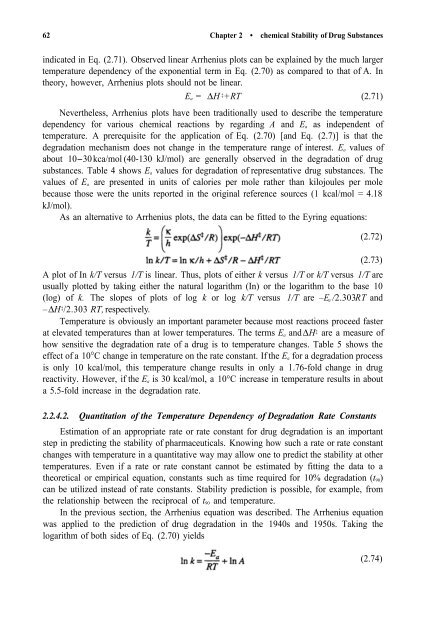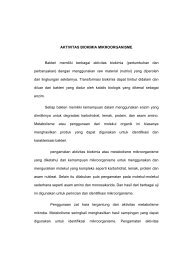Stability of Drugs and Dosage Forms Sumie Yoshioka
Stability of Drugs and Dosage Forms Sumie Yoshioka
Stability of Drugs and Dosage Forms Sumie Yoshioka
Create successful ePaper yourself
Turn your PDF publications into a flip-book with our unique Google optimized e-Paper software.
62 Chapter 2 • chemical <strong>Stability</strong> <strong>of</strong> Drug Substances<br />
indicated in Eq. (2.71). Observed linear Arrhenius plots can be explained by the much larger<br />
temperature dependency <strong>of</strong> the exponential term in Eq. (2.70) as compared to that <strong>of</strong> A. In<br />
theory, however, Arrhenius plots should not be linear.<br />
E a = ∆ H ‡ +RT (2.71)<br />
Nevertheless, Arrhenius plots have been traditionally used to describe the temperature<br />
dependency for various chemical reactions by regarding A <strong>and</strong> E a as independent <strong>of</strong><br />
temperature. A prerequisite for the application <strong>of</strong> Eq. (2.70) [<strong>and</strong> Eq. (2.7)] is that the<br />
degradation mechanism does not change in the temperature range <strong>of</strong> interest. E a values <strong>of</strong><br />
about 10-30 kca/mol (40-130 kJ/mol) are generally observed in the degradation <strong>of</strong> drug<br />
substances. Table 4 shows E a values for degradation <strong>of</strong> representative drug substances. The<br />
values <strong>of</strong> E a are presented in units <strong>of</strong> calories per mole rather than kilojoules per mole<br />
because those were the units reported in the original reference sources (1 kcal/mol = 4.18<br />
kJ/mol).<br />
As an alternative to Arrhenius plots, the data can be fitted to the Eyring equations:<br />
(2.72)<br />
(2.73)<br />
A plot <strong>of</strong> In k/T versus 1/T is linear. Thus, plots <strong>of</strong> either k versus 1/T or k/T versus 1/T are<br />
usually plotted by taking either the natural logarithm (In) or the logarithm to the base 10<br />
(log) <strong>of</strong> k. The slopes <strong>of</strong> plots <strong>of</strong> log k or log k/T versus 1/T are –E a /2.303RT <strong>and</strong><br />
–∆ H ‡ /2.303 RT, respectively.<br />
Temperature is obviously an important parameter because most reactions proceed faster<br />
at elevated temperatures than at lower temperatures. The terms E a <strong>and</strong>∆ H ‡ are a measure <strong>of</strong><br />
how sensitive the degradation rate <strong>of</strong> a drug is to temperature changes. Table 5 shows the<br />
effect <strong>of</strong> a 10°C change in temperature on the rate constant. If the E a for a degradation process<br />
is only 10 kcal/mol, this temperature change results in only a 1.76-fold change in drug<br />
reactivity. However, if the E a is 30 kcal/mol, a 10°C increase in temperature results in about<br />
a 5.5-fold increase in the degradation rate.<br />
2.2.4.2. Quantitation <strong>of</strong> the Temperature Dependency <strong>of</strong> Degradation Rate Constants<br />
Estimation <strong>of</strong> an appropriate rate or rate constant for drug degradation is an important<br />
step in predicting the stability <strong>of</strong> pharmaceuticals. Knowing how such a rate or rate constant<br />
changes with temperature in a quantitative way may allow one to predict the stability at other<br />
temperatures. Even if a rate or rate constant cannot be estimated by fitting the data to a<br />
theoretical or empirical equation, constants such as time required for 10% degradation (t 90 )<br />
can be utilized instead <strong>of</strong> rate constants. <strong>Stability</strong> prediction is possible, for example, from<br />
the relationship between the reciprocal <strong>of</strong> t 90 <strong>and</strong> temperature.<br />
In the previous section, the Arrhenius equation was described. The Arrhenius equation<br />
was applied to the prediction <strong>of</strong> drug degradation in the 1940s <strong>and</strong> 1950s. Taking the<br />
logarithm <strong>of</strong> both sides <strong>of</strong> Eq. (2.70) yields<br />
(2.74)
















